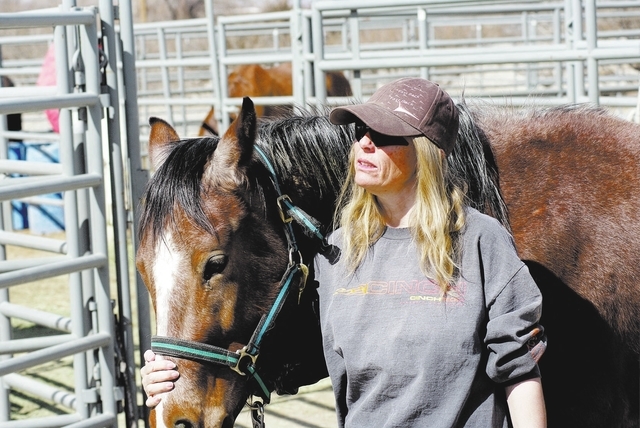Hay farmers continue valley’s harvest tradition
It’s been almost 50 years since Pahrump Valley pioneers like Tim Hafen, Bob and Jacquie Ruud, Ron and Charlotte Floyd organized the first Harvest Festival in 1965.
After 37 years the name was changed to the Pahrump Fall Festival when the town of Pahrump took it over in 2002. The town has run it ever since — except for a few years under the management of the Pahrump Alliance for Valley Economic Development (PAVED). The town took over the event again last year and is the driving force behind this year’s event.
Hafen recalls 1965 was the year Pahrump Valley got telephones and two years after electrical service. He said Charlotte Floyd was an instigator of the Harvest Festival, which they had back where she came from in Chowchilla, Calif.
“We wanted to promote Pahrump to the outside world. This was one way of doing it, of getting outsiders to come in,” Hafen said.
“Cotton was our most valuable crop. It was a pretty good crop money-wise, so with the horsepower requirement we were able to get enough of an electricity load to get electricity in here, switch out the diesel engines. Cotton made the valley because it enabled electricity to come in. That’s one of the most important things you need to form a community,” Hafen said.
Cotton is no longer harvested in Pahrump. When agriculture was king, water consumption was at its highest in 1967, with 45,000 acre feet of water pumped, by 2011 that figure dropped to 13,352 acre feet. But Hafen said it was the oil embargo in the 1970s that helped ensure the demise of cotton farming here.
The cotton gins are gone and many of the large parcels of green fields have been replaced by subdivisions. But a small group of farmers are still harvesting alfalfa. One of the largest spreads is the Pahrump Dairy, where the cows are gone but hay is still being raised for cows in Amargosa Valley.
Gary Bowman farms about 100 acres at the bottom end of Mountain Falls subdivision.
“It’s that spring water is why I’m doing it still. The spring is just running. I’m making beneficial use of that water so I can keep the water rights current. That’s what everybody is pretty much doing actually,” Bowman said.
He uses his truck to deliver hay to locals for $15 per bale, about $5 under the price at feed stores. This year he just finished his fifth cutting.
It’s much different than when he was a boy. His father Perry Bowman, another Pahrump pioneer, farmed on a section of land, 640 acres. Bowman said his family received permits from the U.S. Bureau of Land Management to run cattle on the west side of Pahrump Valley and in the Spring Mountains from 1946 until the 1990s. Bowman said his uncles divided up parts of the ranch, some are now owned by Focus Property Group and Adaven, a company with plans to build a Mountain Falls South subdivision.
Zolina Burson grows alfalfa on 80 acres across from Golden Casino Group’s Lakeside RV and Casino on Homestead Road. She rotates crops, leaving 20-acre pieces fallow for three years, replanting on the fourth year.
“I don’t really grow it for the crop any more, we grow it just to keep the water rights up. It’s an ‘in the red’ type of deal,” Burson said. “It’s like a long type investment because the water rights are worth more than the crops. It kinds of pays its own bills but that’s about it.”
Burson said she sells some of her product and feeds hay to her animals. “It kinds of feeds my habit because I have a horse habit and a goat habit. My kids are in 4-H.”
Retired construction worker Chuck Price has 17.5 acres of grass and alfalfa on Gamebird Road just west of Homestead Road. He also raises longhorn cattle, with eight adults and some newly-born calves, who eat some of his crop.
“I feed and sell. I sell a little bit,” Price said. “It gives me something to do.”
Price had four cuttings of hay this year. Some years he’s had six cuttings, even seven. He sells the bales for $15 to $18 but said, “there’s no living there, I’m just doing it for fun.”
Fred and Cathy Cressler bought land at the south end of Homestead Road near the brothels 21 years ago. They’re still growing hay on 23 acres. Cathy Cressler said they get between 275 and 300 bales per cutting, with around five cuttings this year.
Their customers are mostly locals with horses or goats. The Cresslers deliver the hay. “The ones that are buying from us tell us it’s a better price than if they went to the feed stores. It’s anywhere between $10 and $15 (per bale) and they’re three-wire bales,” she said.
Cressler said in her area numerous landowners from Homestead Road to Squaw Valley Road are growing hay, but that’s had an effect on the water table.
“A few years ago Fred had to have Great Basin (Drilling) come out and go down another 100 feet because we were losing our suction,” she said. “Alfalfa uses a lot of water.”
But she added, “He’s learned to conserve water because the first few years we were watering every day and it was just crazy. So our electric bills for the pump usually run about $500 per month for 10 acres.”
The farm gives Fred Cressler, 72, something to do in his retirement, she said.
“We pretty much break even. It’s just a little extra so we can go out to dinner and Fred can keep his equipment up and running,” Cathy Cressler said. She added, “I love the smell of fresh cut hay.”
Hafen, who began farming after moving to Pahrump in 1951, reduced his 800 acres of farmland down to 200 acres about 10 years ago. In 2004 he sold the rest of the farm and the last of his cattle and converted his water rights to municipal use.
Hafen used to use the saying, “I’m farming for respectability, but selling real estate for the money.”
















